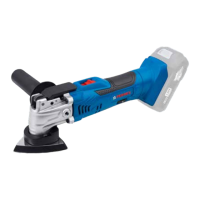Operation
20
− To remove the sanding sheet, take hold of it by the tip and pull it off of the
sanding plate.
Operation
Preselecting the oscillation rate
You can use the oscillation rate preselector
5
to adjust the speed variably between
5,000 and 16,000 rpm.
Level 1 represents the minimum oscillation rate; level 6 represents the maximum
oscillation rate. You can adjust the oscillation rate while the multifunction-tool is
switched on.
− To set the oscillation rate, turn the oscillation rate preselector to the desired level.
The required oscillation rate depends on the work material and the working
conditions and must be determined in practice.
Switching the multifunction tool on and off
− To switch the multifunction tool on, push the On/Off switch
3
towards the tool
holder
8
.
The digit 1 on the On/Off switch, which can be read in this position, indicates that
the multifunction tool is switched on.
The worklight
6
automatically turns on when the multifunction tool is switched
on.
− To switch the multifunction tool off, push the On/Off switch towards the battery
holder
4
.
The digit 0 on the On/Off switch, which can be read in this position, indicates that
the multifunction tool is switched off.
Working with the multifunction tool
Sawing
The plunge-cut saw blade
9
and the segment saw blade
10
and
12
can be
mounted at different angles (between -90° and +90°) depending on your needs. This
way, you can avoid substantial wear of the segment saw blade along a certain edge
area.
− Only use sharp saw blades in undamaged, good condition. Bent or dull saw
blades could brake, negatively affect the cut or cause kickback.
− Before sawing wood, chipboard, building materials, etc. check the material for
any foreign objects, such as nails, screws, etc.
− Remove the foreign objects or use saw blades suitable for sawing steel
(e.g. bi-metal saw blades).
When plunge cutting, only soft materials like pine/spruce wood, gypsum cardboard or
the like may be processed.

